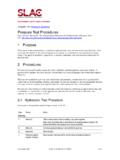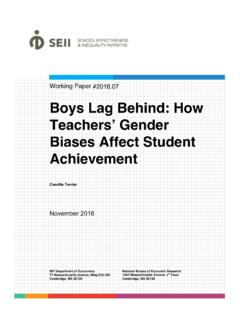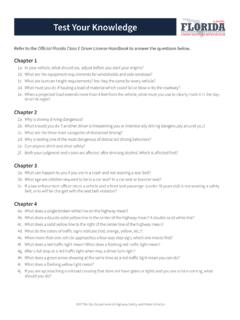Transcription of California DMV Test
1 Visit for more help sheets and free DMV practice tests . California DMV Test Mark the correct answers 1. The intersection has a stop sign. Where should you first stop? At the crosswalk or limit line. After the crosswalk. Out far enough to see cross traffic. 2. Which of these statements is true about large trucks? Trucks don t need more space for turns. Trucks don t need more space to stop and start. Trucks are not as maneuverable as passenger vehicles. 3. What is a safety zone? An empty lane next to the freeway dividers. A space set aside for pedestrians.
2 The median strip on a divided highway. 4. When driving 50 mph in a 55-mph speed limit zone, you can be cited for speeding: Under no circumstances, your speed is always legal. Only if you cause an accident. If your speed is unsafe for current conditions. 5. You want to park uphill on a two-way road and there is no curb. Which way do you turn your front wheels? Facing straight ahead. Left - towards the center of the road. Right towards the side of the road. 6. You should use a turnout lane when: Faster drivers want to pass you. You want to make a U-turn.
3 You want to pass another driver. Visit for more help sheets and free DMV practice tests . 7. You can drive in a carpool lane if you: Want to pass the vehicle ahead. Have the minimum number of passengers shown on the sign. Are driving an empty 15 passenger van. 8. When driving in fog, you should use your: Fog lights only. High beams. Low beams. 9. A school bus ahead of you in your lane is stopped with red lights flashing. You should: Stop as long as the red lights are flashing. Slow to 25 mph and pass cautiously. Stop, then proceed when you think all of the children have exited the bus.
4 10. You just sold your vehicle. You must notify the DMV within: 5 days. 10 days. 30 days. 11. Which of the following statements about blind spots is true? They are eliminated if you have one outside mirror on each side of the vehicle. Large trucks have bigger blind spots than most passenger vehicles. blind spots can be checked by looking in your rear-view mirrors. 12. Unless otherwise posted the speed limit in a residential area is: 20 mph. 25 mph. 30 mph. Visit for more help sheets and free DMV practice tests . 13. If your wheels drift off the pavement onto the shoulder: Grip the steering wheel firmly and ease your foot off the accelerator.
5 Slow down quickly by braking hard. Increase your speed and steer quickly back on the road. 14. You are stopped at an intersection. The traffic light just turned green. Can you go immediately? Yes, other traffic or pedestrians must yield to you. Yes, but you must yield to any vehicle or person still in the intersection. Yes, you now have the right-of-way. 15. Which of the following is true about double parking? It is only allowed if you are making a delivery. It is illegal unless you wait in the vehicle. It is illegal under all circumstances. 16. When you are backing out of a parking space: Unbuckle your seat belt so you can back as quickly as possible.
6 Sound your horn to warn other drivers. Back slowly to avoid collisions. 17. Are you permitted to park on a crosshatched pattern space next to a disabled parking? No, not at any time. Yes, if no vehicles are using the disabled parking area. Yes, but for no more than 30 minutes. 18. You are on a street with two lanes in each direction. To turn left, start the turn in: Any lane open to you for traffic in your direction. The left lane for traffic in your direction. The right lane for traffic in your direction. Visit for more help sheets and free DMV practice tests .
7 19. You must make a full stop before you cross railroad tracks when: There are no warning signals or gates at the crossing. The crossing is located in a city or town with frequent train traffic. You don't have room to completely cross the tracks. 20. A solid yellow line next to a broken yellow line means that vehicles: In both directions may pass. Next to the broken line may pass. Next to the solid line may pass. 21. You are driving at night with your headlights on high beam. When must you dim your headlights? When within 500 feet of a vehicle coming toward you.
8 When within 1,000 feet of a vehicle you are following. Never, you are allowed to drive with your lights on high beam at all times. 22. If you see a pedestrian crossing in the middle of the block ahead and there is no crosswalk: Stop and give the pedestrian the right-of-way at all times. Slow to 15 mph as you pass the pedestrian. The pedestrian must yield to you, but you must take care for his/her safety. 23. If drivers want to see cars in their blind spots, they should check: Over their shoulders. The outside rear-view mirror. The inside rear-view mirror.
9 24. You hear the siren of an ambulance approaching you from behind. You should: Slow down to the speed of other traffic. Pull as near to the right edge of the road as possible and stop. Stop immediately, even if you are in an intersection. Visit for more help sheets and free DMV practice tests . 25. Use your headlights on rainy, snowy, or foggy days: So other drivers can see you. On the high-beam setting. To warn others of bad conditions. 26. If you see an orange-colored road sign beside the roadway, it means: There is a school zone ahead. The lane is closed ahead.
10 There is road work ahead. 27. If you're driving and you find that nothing seems to help you stay awake, you should: Turn on your air conditioner and drink coffee. Open your windows and turn up your radio. Pull off the highway and rest. 28. Must you carry your driver's license with you every time you drive? Yes. No, it is only needed when driving out-of-state. No, being licensed is enough. 29. Motorcyclists are more at risk in traffic because: They are careless and do not obey road rules. They are harder to see in traffic. They ride too fast and do not turn their lights on.






